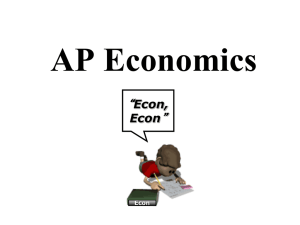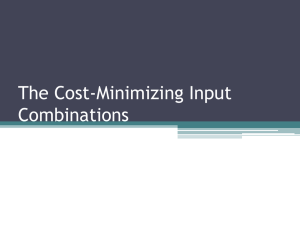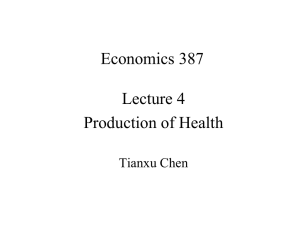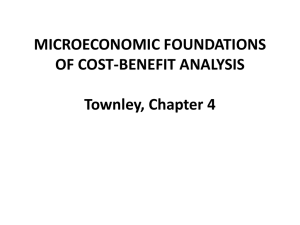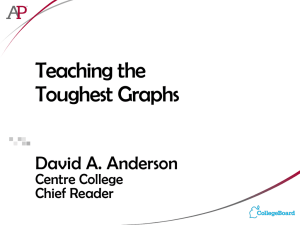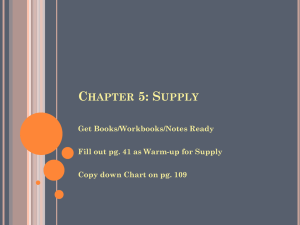Marginal Cost
advertisement
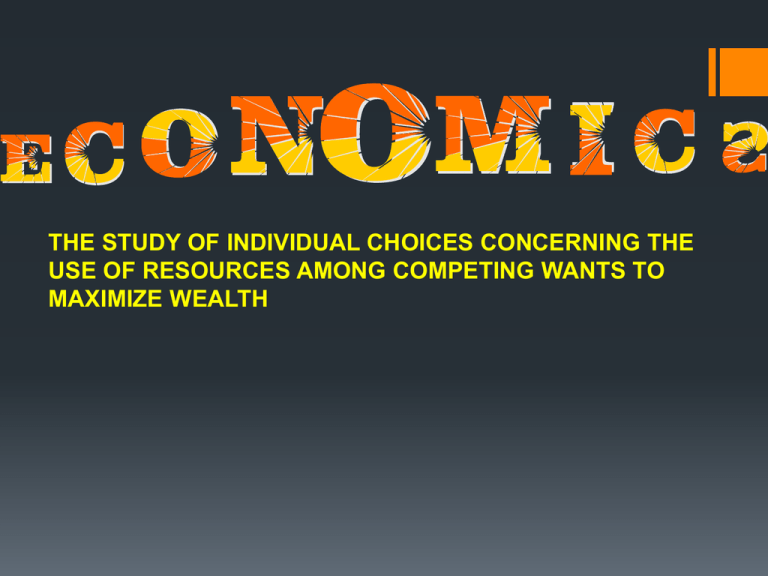
THE STUDY OF INDIVIDUAL CHOICES CONCERNING THE USE OF RESOURCES AMONG COMPETING WANTS TO MAXIMIZE WEALTH Scarcity All resources are limited So, people cannot obtain all that they want they must make a sacrifice or in more economic terms, “Pay a Cost” Scarcity forces YOU to choose among alternatives Resources – What are they? Land Human capital (Labor) Physical capital Entrepreneurship Economics – a way of analyzing choices concerning use of resources Ultimate Goal of Economics: Maximize individual and societal wealth Wealth is the subjective evaluation of well being Economic thinking can be used to maximize your own individual wealth. Economics can be used for social policy to maximize wealth for all members of a society. Here’s the Deal Resources are insufficient to satisfy our unlimited wants. “We can’t have everything we want.” We must make choices – inevitable reality Choices require decisions between alternatives Alternatives create winners and losers So we should be careful about the choices we make. Benefit/Cost Analysis State the goal and identify the resources available to reach the goal. Identify alternative ways to use the resources to achieve the goal. Narrow the alternatives to two. Evaluate the advantages and disadvantages of each alternative. Select the best choice, based on available information The choice not selected is called the opportunity cost. Keep in mind The choice is the alternative selected. The opportunity cost is the alternative not selected, the opportunity given up. Every choice has a cost; there is no such choice as a free choice. DISADVANTAGES ARE NOT COSTS. There is only one cost to each choice. Marginal A little more or a little less. Compare benefits and cost of two alternatives The Solution: Marginal Analysis Every resource use has a benefit and an opportunity cost. We should only use the resource in that activity if the benefit outweighs the OC. Marginal analysis tells us how much of each resource to use in each activity. Using Marginal Benefit/ Marginal Opportunity Cost Analysis Investigating two alternatives What’s the difference in benefits between the two? Is the marginal benefit of the choice greater than the marginal OC? The Marginal Principle How far should I pursue any single activity, knowing that the resources I am using have opportunity costs; they could be doing other things? Ex. You can’t please everyone If the marginal benefit is greater than the marginal opportunity cost, go for it; otherwise, go back! Using Marginal Analysis How long should I wait in the lunch line? As long as the marginal (additional) benefit of getting hot lunch outweighs or is MORE than the marginal cost of time lost with friends. As long as MB (Marginal Benefit) is > MC (Marginal Cost) How long should I continue dating my boyfriend? As long as the marginal (additional) benefit of seeing him is greater than the marginal (additional) cost of seeing better guys. MB > MC How long should I study for the unit test? As long as the marginal (additional) benefit of studying is MORE than the marginal cost of no sleep. MB > MC Opportunity Cost Use opportunity cost to explain the following Why farmers often wait until a rainy day to do errands in town, while a businessman in a new suit will decide to forego his errands on the same day. The opportunity cost (OC) for a farmer doing errands in town on a rainy day is lower than the OC for a businessman doing errands in town on the same day Why businessmen often buy full-fare tickets while people planning vacations fly when rates are lower The opportunity cost for a businessman buying full-fare tickets is higher than that of a family planning a vacation Why movie stars, fashion models and rocksingers have higher divorce rates than the rest of the American population The opportunity cost for a rock star getting divorced are lower than the opportunity cost are for the rest of the American population to get divorced Law of Diminishing Returns Output will ultimately increase by progressively smaller amounts when the use of a variable input increases while other inputs are held constant *The point at which spending more time will result in lesser return Example Ms. Joy decides to start a zucchini garden Year 1 she harvests 20 zucchini! Year 2 she uses 1 pound of fertilizer which results in 30 zucchini!! Year 3 she uses 2 pounds of fertilizer 35 zucchini Year 4 she uses 3 pounds of fertilizer 37 zucchini Year 5 she uses 4 pounds of fertilizer 33 zucchini – less than before…hmmmmmm Year 6 she uses 5 pounds of fertilizer 5 zucchini…all the rest were killed before flowering The Principle of Exchange People will exchange if they gain more than they give; if the value of the choice is greater than the opportunity cost. How do we get what we want? Scarcity causes goods and services to be rationed How do we do this? Who decides on the mechanism? Rationing Methods First-Come, First-Served Merit or Need Arbitrary - Age, Hair Color, Shoe Size Price--a Market System Advantages of a Price System Anonymous - Participants may not know each other’s characteristics Market provides variety Compare relative prices (i.e., opportunity cost) Common Currency - No question of value Individual choice to participate The Market One way to allocate scarce goods and services Relative prices: why? $50,000 $5 Because Scarcity Exists: Scarce goods have to be rationed. Some folks will be told “NO!!!” It’s not fair, everyone will not be happy. Price: unit by which we measure relative scarcity Order these products in terms of relative scarcity a candy bar a yacht a Toyota mini truck a nice dinner for two in LA a ticket to a professional baseball game dinner for one at MacDonald’s a laptop computer Order these products in terms of relative scarcity 7 a candy bar 1 a yacht 2 a Toyota mini truck 4 a nice dinner for two in LA 5 a ticket to a professional basketball game 6 dinner for one at McDonald’s 3 a laptop computer Price The measure of relative scarcity If a product becomes relatively more scarce, the price will rise. If a product becomes relatively less scarce, the price will fall. Market: An interaction of buyers and sellers Necessary Components for a Market Competition Information Property Rights Incentives Property Rights With well defined property rights, owners have incentives to preserve, develop, and improve resources Without well defined property rights, people have incentives to use resources as quickly as possible over fishing The buffalo Economic Systems Three Economic Questions 1. What goods will be produced - What does an economy need to produce to keep its people alive/happy? 2. How will the goods be produced - Should government produce things? - Should things be produced by private citizens? - Why? 3. Who gets what is produced - Will everyone automatically get what is needed? - How will you decide who gets what? Three Types of Economic Systems 1. Traditional Economy - economic decisions made based on tradition, customs, cultural beliefs - self-sufficient, pre-industrial groups - little or no outside trade – barter system 2. Command Economy, Socialism Government ownership of all means of production – all business (factories, farms) -The “THEORY” Everyone contributes according to their ability and receives according to their need Advantages of Socialism - guaranteed employment - guaranteed housing - free education - free medical care Disadvantages of socialism - little incentive to work hard (why??) - inefficient methods of production (more jobs) - inhibits innovation, creativity (no self-interest) - consumer has little choice (no competition) 3. Market Economy, Capitalism, Free Enterprise System - all business decisions are made by business owners and consumers - all decisions based on self-interest Self-interest is the motivator - competition is essential Competition is the regulator - property rights are protected - prices fluctuate based on interaction of supply and demand Advantages of capitalism - hard work is rewarded *overtime pay, raise, promotion - innovation is encouraged – increase profit - flexibility – change happens easily - quality goods are produced and sold at a fair price (competition) Disadvantages of capitalism - unequal distribution of income *few rich, some middle, some poor - financial insecurity bankruptcy, unemployment - high cost of education, health care - subject to inevitable swings of the Business Cycle Reality Check Modern national economies are all a mix of some capitalism and some socialism – Mixed Economies United States - minimum wage, social security, medicare, anti-monopoly legislation China – encourages individuals to own businesses and make profit North Korea – closest to pure socialism


